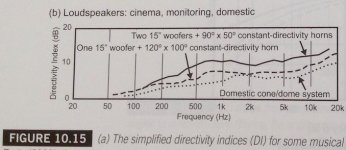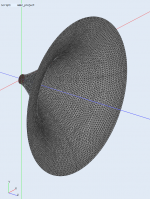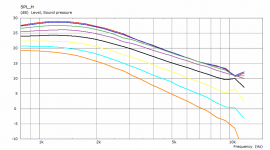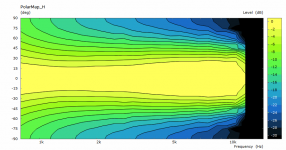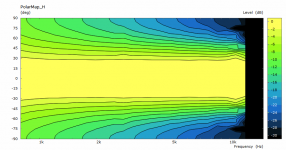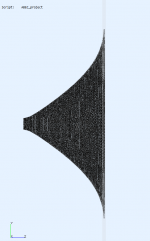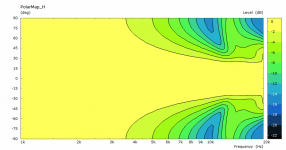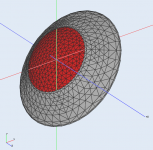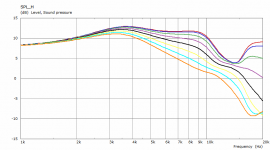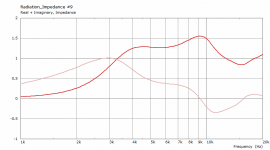Re: Floyd/Geddes differing approaches
A system with an evenly increasing directivity towards the LOW frequencies could maybe meet BOTH designers needs?
So say: 120deg at highs and narrowing to 60deg at the Schroeder room freq.
Ignoring the fact that this would be exceedingly difficult to do - it goes against the natural nature of source acoustics. It is also exactly the wrong thing to do. That's because our ears are more sensitive to the VER at HFs and as such we want less of them, i.e. a higher DI.
S=0.8 is supposedly even better than 0.7?
This driver features an exit size that's a smaller than usual, unfortunately the breakup looks less attractive. The same applies to the TN version.
This driver features an exit size that's a smaller than usual, unfortunately the breakup looks less attractive. The same applies to the TN version.
Last edited:
This is a great lead-in to where Floyd and I disagree, or not really disagree so much but have different Preferences.
First there are some things that need to be understood: 1) very early reflections (VER) are know to enhance spaciousness but degrade imaging; and 2) as the DI is increased the VER are decreased. These two factors are key to the discussion.
Floyd listens almost exclusively to live recordings of large orchestras in large venues. This type of recording is heavy on spaciousness and very light on imaging as a high number of instruments means poor source localization. The best playback in this case would be a low DI with a multichannel setup. This type of setup would indeed obliviate any importance of DI in the main speakers. This is precisely the situation that Floyd is in and why he does what he does.
On the other hand many people, like myself, prefer studio work where imaging is essential and multichannel more of a degradation rather than an enhancement. I never upmix my 2 channel sound to multi-channels. In this case a high DI is very important to recreating the image that is presented by the recording.
It's the high DI that is difficult to achieve in small designs and particularly with direct radiators, hence my preference for CDs and waveguide as this is the only way to achieve a smooth and constant high DI
In a very real sense one must taylor their systems to their musical preferences. This is what Floyd means when he says "There is much discussion of this in forums, and personal preference is a factor." Personal preference here means musical interest and expectation. There is no single right answer, Floyd knows this as well as I do.
My point here is to make it clear that we need to understand what we want from our recordings and this is a personal choice. So it can be wrong to use the recommendations or observations of one experts designs when applied to another's designs which may be seeking something different. This is the situation between Floyd and myself and many others I suspect. Many think that there is a single answer to the problem, but there isn't.
And I also agree with "Patrick" in that IMO as speakers get better and better they tend to converge on sound quality - sounding ever more similar. It's flawed speakers that sound different because there are a million different flaws, but flawless speakers should all sound about the same. Except for DI where there isn't a single right answer and some speakers will sound better with some material and rooms and others the opposite.
Thank you, that has been helpful. It also means I am cursed, with my wide tastes.
Where would your speakers plot on this DI chart?
I would be a little surprised if suitability for music types switched between the dotted and the dashed lines. But that is the hypothesis being put forward, so I will take it seriously. Also, someone commented that the shape of the DI plot is more important than the height. I take it you would not agree?
P.S. my hifi is XT1086-based, so I am not taking pot shots, I am on board, just testing discussion points.
cheers
Attachments
That is expectable but of course with diminishing returns - paid by a larger device. There's a point you have to say it's good enough. BTW, the "s" is not upper bounded, can be arbitrarily high number - value of 0.8 is only the beginning 🙂S=0.8 is supposedly even better than 0.7?
0.8 makes the wg 50 cm Ø, which is almost perfect. 52cm would be ideal from a cosmetic pov 😉
The driver on the left with 1" exit, 2" diaphragm should be fine at 700Hz:

It's about €60-80 excl. shipment.
The driver on the left with 1" exit, 2" diaphragm should be fine at 700Hz:

It's about €60-80 excl. shipment.
Last edited:
Here's the project. Just download free version of ABEC and run it... Only be prepared it will take some time.It makes me wonder whether the sims of an oversized axysymmetric wg would look even better, say 76 or 80 cm Ø.
Attachments
Mr. Geddes, my intuition may be wrong but it's responding: "wait a second..."
This is a fundamental matter in the reproduction of sound in a listening room. I believe without understanding this, I may be in a dead end for a while, even after this corona virus clears.
Maybe someone can correct my logic but this is how I arrived at my conclusion:
if a given recording is captured via microphone than that recording already contains the correct freq balance and information of the acoustic space of the sound. We do not need to add to it. When that recording is played back in a listening space, the "room" will start to reflect and interact in an increasing manner towards the lower range of frequencies as the sound waves are becoming larger and the speaker is becoming a more omnidirectional source. While the recording already contains the intended amount of frequency balance, the "room" starts to interact disproportionally, more so as the frequencies decrease. To counter balance this effect, I came to the conclusion that the speaker system needs to become MORE directional in the lower frequencies, to counteract the increasing room interaction. I would say, an inversely proportional function. That is, to the point of the Schroeder freq of the room, just because that term sounds convincing. And also because it will be difficult to maintain directionality at very low freq.
Other than the Schroeder freq., what's the fault with this reasoning?
This is a fundamental matter in the reproduction of sound in a listening room. I believe without understanding this, I may be in a dead end for a while, even after this corona virus clears.
Maybe someone can correct my logic but this is how I arrived at my conclusion:
if a given recording is captured via microphone than that recording already contains the correct freq balance and information of the acoustic space of the sound. We do not need to add to it. When that recording is played back in a listening space, the "room" will start to reflect and interact in an increasing manner towards the lower range of frequencies as the sound waves are becoming larger and the speaker is becoming a more omnidirectional source. While the recording already contains the intended amount of frequency balance, the "room" starts to interact disproportionally, more so as the frequencies decrease. To counter balance this effect, I came to the conclusion that the speaker system needs to become MORE directional in the lower frequencies, to counteract the increasing room interaction. I would say, an inversely proportional function. That is, to the point of the Schroeder freq of the room, just because that term sounds convincing. And also because it will be difficult to maintain directionality at very low freq.
Other than the Schroeder freq., what's the fault with this reasoning?
OS WG, Ø 65 cm (~26").
Polar map normalized to 0° and 20° (as usual) on the two pictures. For these very smooth waveguides it may have sense to show the polar maps normalized to on-axis sound (?).
I forgot to change the lower frequency limit - next time.
I guess now it is time to start analyzing the full-space situation, i.e. with the horn put out of the infinite baffle. This was the easy part 🙂
Polar map normalized to 0° and 20° (as usual) on the two pictures. For these very smooth waveguides it may have sense to show the polar maps normalized to on-axis sound (?).
I forgot to change the lower frequency limit - next time.
I guess now it is time to start analyzing the full-space situation, i.e. with the horn put out of the infinite baffle. This was the easy part 🙂
Attachments
The profile used - it is 35 cm deep.
BTW, I see no further improvement other than the extended pattern control down to lower frequencies. If this wasn't needed it would make no sense to use such big waveguide - at least not in a baffle/box. For a free standing horn, it might be different I'd guess.
BTW, I see no further improvement other than the extended pattern control down to lower frequencies. If this wasn't needed it would make no sense to use such big waveguide - at least not in a baffle/box. For a free standing horn, it might be different I'd guess.
Attachments
Last edited:
This IS the trade off. An elliptical mouth will allow for a smaller... but it also make the vertical polar control worse. Pick your poison...
Did you ever consider to push the woofer closer to the horn axis, just let it take a small "bite" out of the mouth?
The relationship between the distance between the axes and the bite area is non linear- the bite area increases approximately quadratically as the axis separation falls linearly so obviously can't be pushed too far.
But it seems a small bite would have minimal impact on the horn polar yet improve the vertical combined polar.
Maybe the broken symmetry could help eliminate the on axis holes of axisymmetry too?
I know you consider these rather unimportant but potentially a nice bonus.
Best wishes
David
Isn't it easier to prevent the holes altogether?Maybe the broken symmetry could help eliminate the on axis holes of axisymmetry too?
My NS-15 would be at about the top curve in the plot but smoother and flatter.Thank you, that has been helpful. It also means I am cursed, with my wide tastes.
Where would your speakers plot on this DI chart?
I would be a little surprised if suitability for music types switched between the dotted and the dashed lines. But that is the hypothesis being put forward, so I will take it seriously. Also, someone commented that the shape of the DI plot is more important than the height. I take it you would not agree?
Whether or not the differences in the DI would be audible would depend on the room. If it were anechoic then of course no differences would be heard, while in a very lively room they would. My rooms are always very lively at HFs so I would expect to hear the differences in that case.
Shape and level are two different things and both are important, but I would agree that shape is more important than level up until you have a very smooth flat shape, then the level become the most important. I do both.
Mr. Geddes, my intuition may be wrong ...
When that recording is played back in a listening space, the "room" will start to reflect and interact in an increasing manner towards the lower range of frequencies as the sound waves are becoming larger and the speaker is becoming a more omnidirectional source.
This statement is incorrect. The room reflects all frequencies equally, but in detail this depends on the room of course. But there is no increase in reflections and interactions as the frequency falls. The issue is how we perceive those reflections and this is highly frequency dependent. At LFs there are standing waves that are widely separated and don't interact much, but as the density of the mode density increases and they interact more and more. The transition from discrete enough to not interact to dense enough so that interaction is constant is called the Schroeder Frequency - about 200 Hz in a typical home listening room.
It would be wise not to use the word "larger" when talking about wavelength since it implies "greater". The wavelengths get longer, but not larger at LFs.
Did you ever consider to push the woofer closer to the horn axis, just let it take a small "bite" out of the mouth?
I did precisely that in the NA-12 when I used a larger waveguide but kept the spacing the same. I did not notice much of an effect of this either way.
Isn't it easier to prevent the holes altogether?
Certainly doable, but maybe not "easier" depending on your resources. For me it was not that easy since I did most of my molds on a lathe. As I said, CNC was very expensive, but, of course, anything is easy with cheap access to one of those.
Last edited:
Is there a way to simulate the effect of a wrap-around mouth termination?The profile used - it is 35 cm deep.
BTW, I see no further improvement other than the extended pattern control down to lower frequencies. If this wasn't needed it would make no sense to use such big waveguide - at least not in a baffle/box. For a free standing horn, it might be different I'd guess.
That's what I'm working on now. Seems easier than anticipated. But I don't expect the results to be pretty. It will probably need some rolling back which I would like to avoid as much as possible.
Last edited:
It may be tough if there are constraints on the enclosure size but it's certainly doable on a lathe....Certainly doable, but maybe not "easier" depending on your resources. For me it was not that easy since I did most of my molds on a lathe. As I said, CNC was very expensive, but, of course, anything is easy with cheap access to one of those.
Here's the project. Just download free version of ABEC and run it... Only be prepared it will take some time.
Thanks. Sims will have to wait until I finish upgrading my workstation though (so far I have received an m.2 ssd, but still need the processor and a few extra sticks of 16GB ram).
The last time I tried running a sim on a laptop, I had to abort it.
Last edited:
Stay tuned, I'm just about to release version 4.5.0 which will be a major update with all the features long time waiting to be released.
One quick example - a 30 mm dome in a short conical recess. This kinds of little things will be possible. This took me about 2 minutes from writing the script file to upload the BEM results 🙂
(A big waveguide could also be placed on top of that).
One quick example - a 30 mm dome in a short conical recess. This kinds of little things will be possible. This took me about 2 minutes from writing the script file to upload the BEM results 🙂
(A big waveguide could also be placed on top of that).
Attachments
It may be tough if there are constraints on the enclosure size but it's certainly doable on a lathe.
Of course, a huge waveguide won't have axial holes as long as the mouth has a large radius flange. But in a "marketable" size this is a problem.
Or a concave one, no problem..One quick example - a 30 mm dome in a short conical recess. This kinds of little things will be possible. ...
Attachments
Hi Marcel,
Thank you,
M
Why not - I don't plan to sell it (as you don't, I hope).
Thank you,
M
- Home
- Loudspeakers
- Multi-Way
- Acoustic Horn Design – The Easy Way (Ath4)
